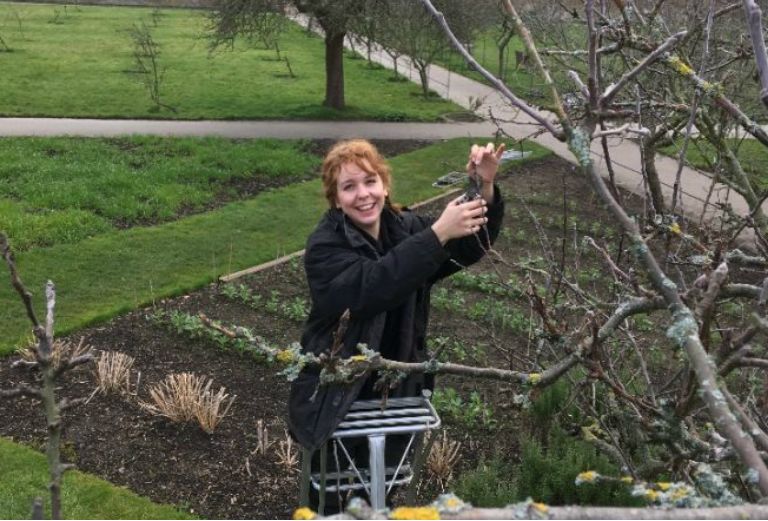
by Ellie Edmonds, garden apprentice
Last month we pruned the apple trees in the walled garden. We have a range of trees of different ages throughout the garden, including our oldest apple, the historic Malus ‘Blenheim Orange’ that produces masses of crisp orangey red fruit that have a dual purpose; they are delicious to eat and cook with. Initially we focussed on the orchard, where many types of heritage apple cultivars were introduced in 2014, and are already producing fruit. These heritage varieties once developed as a result of people experimenting with seed grown apples, resulting in unique varieties.
Our orchard trees have been grafted on a semi vigorous rootstock, but the ground below had to undergo extensive archaeology investigation to check no archaeology would be damaged by exploring roots. Currently at around a metre and a half, they require formative pruning to encourage an open, balanced, healthy structure. Pruning in a goblet shape with three to five main branches allows sunlight to reach the fruit and branch, to aid fruit formation and discourage disease like powdery mildew, to which these tree are susceptible. We pruned the tips of the strongest branches by a third, encouraging the tree to produce vigorous growth by altering the hormone balance of the tree.
We also removed any downward growths, and dead, diseased or damaged branches for the general health of the tree. We were careful not to take more than 20% of the tree’s mass, as this would encourage non-fruiting water shoots (very vigorous upright stems) to form which impede fruit production.
Our lovely garden volunteers helped us to prune the trees along the central apple arch, removing any overhanging low growth (that could pose a potential risk to unsuspecting joggers!). We paid extra attention to a tree with blossom wilt, which is a fungal disease that attacks the flowers preventing fruit from forming. The disease can be pruned out by removing all damaged tissue, which is then incinerated rather than composted, to avoid the spread of spores back into the garden. Our secateurs were also disinfected after use, to avoid the spread of the disease to healthy trees.
Take a stroll through the walled garden to admire our handiwork, and keep an eye out for the team sowing seeds in the garden over the next few weeks. Our apple trees will fruit in the autumn, and will produce a range of cooking and eating varieties, which will be available on the garden barrow, and at Apple Day on Sunday 6th October!